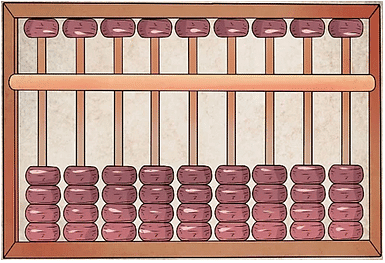Counting | Abacus - Class 1 PDF Download
Steps of Counting
1. Orient your abacus properly
 Each column in the top row should have one or two beads per row, while each column in the bottom row should have four. When you start, all of the beads should be up in the top row, and down in the bottom row. The beads in the top row represent the number value 5 and each bead in the bottom row represents the number value 1.
Each column in the top row should have one or two beads per row, while each column in the bottom row should have four. When you start, all of the beads should be up in the top row, and down in the bottom row. The beads in the top row represent the number value 5 and each bead in the bottom row represents the number value 1.
2. Assign each column a place value

As on a modern calculator, each column of beads represents a "place" value from which you build a numeral. So, the farthest column on the right would be the "ones" place (1-9), the second farthest the "tens" place (10-99), the third farthest the hundreds (100-999), and so on.
- You can also assign some columns to be decimal places if necessary.
- For example, if you are representing a number like 10.5, then the furthest right column would be the tenths place (the first decimal place), the second column would be the ones place, and the third column the tens place.
- Likewise, to represent a number like 10.25, the furthest right column would be the hundredths place, the second column would be the tenths place, the third the ones place, and the fourth the tens place.
3. Start counting with the beads in the lower row

To count a digit, push one bead to the "up" position. "One" would be represented by pushing a single bead from the bottom row in the farthest column on the right to the "up" position, "two" by pushing two, etc.
- You'll find it easiest to use your thumb to move the beads in the bottom row, and your index finger to move the beads in the top row.
4. Complete the "4/5 exchange”

Since there are only four beads on the bottom row, to go from "four" to "five," you push the bead on the top row to the "down" position and push all four beads from the bottom row down. The abacus at this position is correctly read "five." To count "six," push one bead from the bottom row up, so the bead in the top row is down (representing a value of 5) and one bead from the bottom row is up.
5. Repeat the pattern for higher numbers

The process is essentially the same across the abacus. Go from "nine," in which all the beads in the ones place are pushed up and the bead in the top row is pushed down, to "ten," in which a single bead from the bottom row of the tens place is pushed up (while the beads in the ones place are pushed back to their starting or "0" position).
- For example, 11 would have one bead in the second column pushed up, and another in the first column pushed up, all on the bottom row. Twelve would have one in the second column and two in the first column, all pushed up, and all on the bottom row.
- Two hundred and twenty-six would have two in the third column pushed up in the bottom row, and two in the second column pushed up in the bottom row. In the first column, one bead on the bottom row would be pushed up, and the bead on the top row would be pushed down.
|
23 videos|13 docs|3 tests
|

|
Explore Courses for Class 1 exam
|

|
















